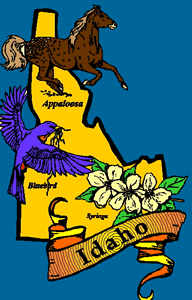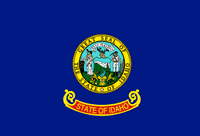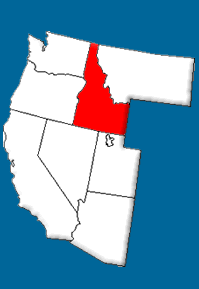 History:
The first Europeans to enter the area we now know as Idaho were probably members of the expedition led by Meriwether Lewis and William Clark in 1805. At this time, present-day Idaho was part of a larger area known as Oregon Country. Lewis and Clark thought the land in Idaho was too dry for farming, but they found fur-bearing animals that would be of interest to traders. David Thompson, a Canadian acting on behalf of the North West Company, established the first trading post in Idaho in 1809, and other fur traders were not far behind. In 1810, Andrew Henry of St. Louis, acting for the Missouri Fur Company, established the first American post in the state near the present-day town of Rexburg. Further exploration brought more settlers to the area. John Jacob Astor, one of the richest men in the United States, was interested in the lucrative fur trade, and he sent an expedition out to explore the Columbia River region and the Snake River. His fur trading post, Astoria, was established in 1811.
Oregon Country (of which Idaho was a part) was jointly controlled by the United States and Great Britain from 1818 to 1846. In the 1820s, the British fur trading companies, particularly the Hudson's Bay Company, came into competition with American fur trappers and traders, and by the 1840s, these two groups had severely depleted the state's fur supply. The decline in supply came at the same time fashion tastes for fur hats for men began to change, and by the 1840s, the fur trade was far less important across the United States.
In 1846, the United States and Great Britain agreed to turn over a portion of the Oregon Country to the United States, including the area we now call Idaho, and in 1848, Oregon Territory was created. In 1859, Oregon became a state, and the eastern part of Idaho was added to what was then called Washington Territory. It was not until 1860 that the first permanent white settlement was established in Idaho at Franklin by Mormon settlers. These first settlers began to irrigate the land and plant potatoes.
At the same time, however, gold was discovered on the Clearwater River in 1860, on the Salmon River in 1861 and on the Boise River in 1862. Both silver and gold were found along the Owyhee River in 1863. Prospectors including many Chinese miners, came to Idaho in great numbers hoping to strike it rich. At one time, nearly one-quarter of Idaho's population was Chinese. Gold rush towns grew up overnight, but when the settlers ran out of money, the towns died as quickly as they had grown, becoming "ghost towns." In the end, enough settlers from surrounding territories and states like Washington, Oregon and California came to Idaho that the United States formally recognized Idaho Territory with its own government in 1863.
The influx of white settlers put pressure on Native American tribes living in the area. These groups, including the Kootenai, Nez Perce, Western Shoshone, Bannock, Coeur d'Alene and Pend d'Oreille Indians, resisted, sometimes violently. In time, however, the United States government and its Army forced the Indians off their land and into reservations. In 1876--77, the Nez Perce, led by Chief Joseph, attempted to flee the area and resettle in Canada, but their endeavor ultimately failed when winter set in and the people were subjected to cold and starvation. By the 1880s, all Native Americans in Idaho had been relocated to reservations.
During the 1880s, railroads were being built across Idaho, and mining operations had a more efficient method for shipping minerals to other states. This brought a second mining boom to Idaho, particularly with the discovery of gold in 1882 along the Coeur d'Alene River. In the end, the gold wasn't there, but miners discovered some of the richest silver mines in the world, along with profitable lead mines. In 1890, nearly 90,000 people were living in Idaho, and the Territory was granted statehood. |









